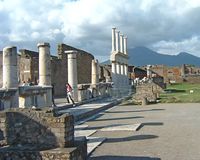CZ:Featured article/Current
Pompeii
Pompeii was a Roman settlement in Campania, situated where the River Sarno drains into the Bay of Naples. When Pompeii was founded and who by is uncertain,[1] but by the mid-6th century occupied an area of 66 hectares. In the 1st century it became a Roman colony. In A.D. 79 Pompeii and nearby Herculaneum were buried when Mount Vesuvius erupted. The settlement was preserved and has become an important archaeological site. In Roman mythology, Pompeii was founded by Hercules and may have been where the cult dedicated to the demi-god originated.[2]
The site of Pompeii was lost until the 18th century. Marble which had been worked on by masons was found in the area, and led to investigations which resulted in the discovery of Herculaneum. In 1748, Pompeii itself was discovered. In this first phase of rediscovery, investigations were funded by the wealthy but inflicted much damage on the site as artworks were taken away to be displayed in the patrons' homes. Pompeii and Herculanuem gained international renown in 1762 due to the writings of Joachim Winckelmann, but the first rigorous archaeological excavations only began in 1860.[3]
The reason Pompeii is so well known today is not because it was exceptional in its time, but because of its remarkable preservation which offers archaeologists insight into the Roman way of life. In the words of Alison E. Cooley and M. G. L. Cooley: "Pompeii was not a particularly significant Roman town. ... No Pompeian made his mark on Roman literature or politics. No crucial moments in Rome's history hinge on Pompeii. Yet today, because of the accident of its fate, Pompeii is a Unesco world heritage site, attracting up to five hundred times as many visitors each year as actually used to live in the town."[4]
| notes |
|---|
|
